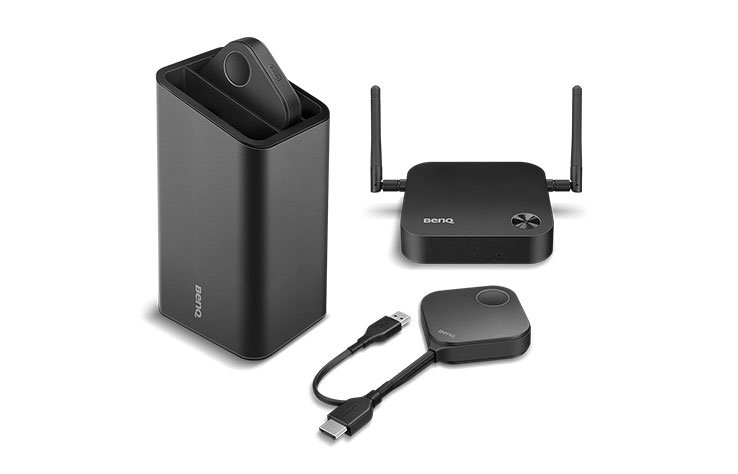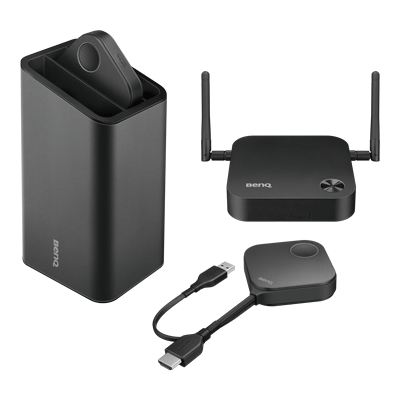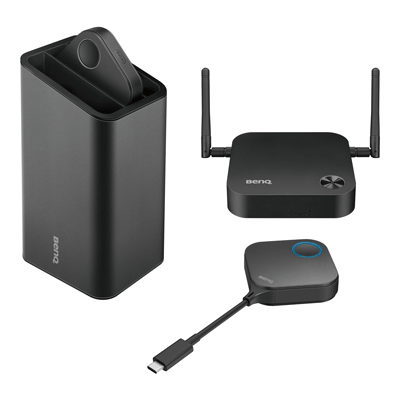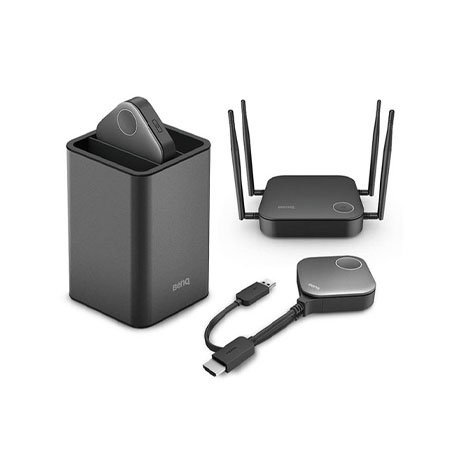Are Wireless Presentations Expensive? - Calculate TCO
- BenQ
- 2020-05-03
For IT staff, the support requirements of meeting rooms are both unique and demanding. With the rapid growth of informal spaces such as huddle spaces and collaboration rooms, being able to effectively support both employees and visitors is an emerging challenge for IT staff.
Wireless presentations systems offer the ability to socially distance presenters in a meeting rooms at a lower cost than reconfiguring legacy cable systems. But how do administrators compare different types of systems using a cost of ownership approach such as the Gartner TCO model, where one-time costs, including both hardware and labor, as well as identifiable recurring costs are used to calculate the total cost of ownership over a specific time frame?
Three Unique Architectures for Corporate Wireless Presentation Systems
While there are over 30 different brands of wireless presentation systems on the market to choose from, they each break down to three distinct architecture types that enable presenters to present content on a shared display. So what are the key cost elements of each type and how do they stack up?
To properly evaluate these systems using the Gartner model, we will look at the following typical costs associated with each type of wireless system.
- Initial equipment costs (e.g. wireless buttons and receiver)
- Labor to set up and install the wireless presentation system in the room
- Labor – Network configuration
- Labor – Security and performance testing
- Labor – App deployment (if needed)
- Labor – App training (if needed)
- Labor – Custom programming (if needed)
- Software – Annual subscription costs 30 different brands of wireless presentation systems
- Labor – Network monitoring & device management
- Labor – App updates (if needed)
- Labor – App training (if needed)
- Labor – Custom programming (if needed)
The BenQ InstaShow and Barco ClickShare are examples of a wireless presentation solution that uses a physical transmitter or “button” that plugs into your HDMI or USB-C port on the notebook to share a projector. Both systems can operate independently of the corporate network but have the ability to connect to the network for management tasks such as screen messages, firmware upgrades, and remote button pairing. According to Futuresource, this architecture is the most popular architecture for wireless presentation systems in North America in 2018, representing 43% of all wireless presentation systems sold. These systems have higher initial equipment costs, but can be installed in minutes without IT support, and do not have any significant identifiable recurring costs.
Recommended Product
Wireless Connectivity Solution BenQ InstaShow

- No cable clutter
- Compatible with multiple devices
Architecture #2 - Wireless AV Control Systems
AV Control systems such as Crestron, AMX, and Extron have been used in larger meeting rooms and boardrooms for years. While these systems have traditionally used HDBaseT and HDMI cabling to route signals from sources to the display, nearly all the major brands of AV control systems now offer wireless connectivity options. The Crestron AirMedia and AMX Enzo are two examples of wireless presentation systems that can be controlled by the custom programming associated with the legacy AV control systems and networks already in place.
These systems account for 22% of the wireless presentation systems sold in North America. The initial equipment costs are similar to button-based systems. However, their complexity and reliance on multiple network components for performance can result in higher installation labor costs, especially if customized programming is needed. These systems typically require a proprietary app to be loaded on the device that will need to be tested and deployed, along with training for meeting room users.
These systems can also have identifiable recurring costs, such as monitoring and device management, as well as additional software costs. For example, Crestron’s Fusion cloud management software has a three-year license MSRP of $20,000. In addition, if the display is changed, these systems may require custom programming to modify the code for the new display.
This architecture is used by many different brands such as Kramer, Airtame, and Mersive and relies on the corporate WiFi infrastructure and proprietary apps to enable notebooks and phones to connect to a shared display. Depending on the brand, the initial equipment price of these systems can be less than a button-based system but may also have higher installation and recurring costs that can impact the overall TCO.
For WiFi Network Hub systems, the overall performance of the system in a meeting is often dependent on the corporate network performance, especially for applications such as streaming video. Many network integration guides require specific bandwidth requirements, ping times, specific network ports, and QoS settings in order for the system to work properly. Because the receiver hubs are active network devices, IT managers need to safeguard against security threats to the corporate main network, as well as protect presentation content from unauthorized viewing over the network.
Due to the need to manage these active network WiFi Hub devices, many models have the recurring costs of separate support products and subscriptions to provide updates and security patches. For example, one major brand offers 20% of the initial cost of the device as an annual fee for each receiver display to provide security and feature updates. These costs, as well as the costs of deploying the updated apps should be considered in the TCO calculation.
TCO Cost Element #1 – Equipment and Installation Costs
To calculate a TCO analysis, we will outline the initial cost estimates based on the typical tasks outlined in the network deployment guides of an entry-level system (1080p resolution) using the internal IT staff to execute at a billable rate of $50 per hour. For this example, we will use the BenQ InstaShow S as a proxy for button-based systems, and popular systems from both AV Control and WiFi Network architectures.
Note that these costs will vary by model and company - and this example assumes only a minimal amount of time for a new or modified VLAN setup. Also, depending on the size of the deployment, these one-time costs will be less if multiple hubs are installed at the same time.
| Setup and Installation Costs |
BenQ InstaShow S | AV Control “A” | WiFi Network Hub "M" |
|---|---|---|---|
Setup and Installation Costs Initial Equipment Cost | BenQ InstaShow S $1499 | AV Control “A” $1,800 | WiFi Network Hub "M" $1199 |
Setup and Installation Costs Network Performance Bandwidth and Performance Audit | BenQ InstaShow S No network needed | AV Control “A” $100 | WiFi Network Hub "M" $100 |
Setup and Installation Costs Baseline Security Standard Audit | BenQ InstaShow S N/A | AV Control “A” – | WiFi Network Hub "M" $100 |
Setup and Installation Costs Open / Configure 10-25 network ports | BenQ InstaShow S N/A | AV Control “A” $25 | WiFi Network Hub "M" $50 |
Setup and Installation Costs Create & Configure VLAN | BenQ InstaShow S N/A | AV Control “A” $100 | WiFi Network Hub "M" $100 |
Setup and Installation Costs Configuring Encryption Security | BenQ InstaShow S N/A | AV Control “A” – | WiFi Network Hub "M" $50 |
Setup and Installation Costs Deploying App on User Notebooks | BenQ InstaShow S N/A | AV Control “A” $50 | WiFi Network Hub "M" $50 |
Setup and Installation Costs Testing and Training | BenQ InstaShow S N/A | AV Control “A” $100 | WiFi Network Hub "M" $100 |
Setup and Installation Costs Total Estimated Costs | BenQ InstaShow S $999 | AV Control “A” $2,175 | WiFi Network Hub "M" $1,749 |
InstaShow S
The BenQ InstaShow does not have any subscriptions or other specifically identifiable network maintenance costs since it is not required to be connected to a corporate network. The unit does not connect to the internet, nor can users bridge to the main network. Its software-free design also eliminates the recurring cost of installing, managing, and updating the software on the employee's notebooks.
AV Control
Because these wireless systems are often incorporated into larger boardroom systems, the incremental recurring costs can be more difficult to calculate. For example, network management products such as Crestron Fusion or Extron GlobalViewer Enterprise are custom quoted, and typically cost allocated over multiple systems. For this example, we will use a small amount as a place holder in this example with one annual software update per year.
WiFi Network Hubs
Products using WiFi Hub model can have specific ongoing costs that should be considered in a TCO analysis. Because these are active network devices that have potential vulnerabilities such as unauthorized access to a device, remote exploitation to change admin and moderator passwords, and even denial-of-service (DoS) conditions, regular security updates should be considered in the TCO model. A number of brands require subscription services after the first year to update their products. The costs below are only estimates and are based on the deployment guides from popular models in this category.
| Identifiable Recurring Costs | BenQ InstaShow | AV Control “A” | WiFi Network Hub “M” |
|---|---|---|---|
Identifiable Recurring Costs Network Monitoring | BenQ InstaShow $0 | AV Control “A” $100 | WiFi Network Hub “M” $100 |
Identifiable Recurring Costs Software Subscriptions (vary by brand) | BenQ InstaShow $0 | AV Control “A” $100 | WiFi Network Hub “M” $200 |
Identifiable Recurring Costs Update End-User Applications (1/year) | BenQ InstaShow $0 | AV Control “A” $50 | WiFi Network Hub “M” $50 |
Identifiable Recurring Costs Security Alert Management | BenQ InstaShow $0 | AV Control “A” $50 | WiFi Network Hub “M” $50 |
Identifiable Recurring Costs Total Estimated Costs | BenQ InstaShow $0 | AV Control “A” $300 | WiFi Network Hub “M” $400 |
Combining Initial and Recurring TCO Costs
While the initial price of the InstaShow is higher than some WiFi network hubs, the overall cost of ownership can be substantially lower over time. The software-free design eliminates the need for both initial and recurring IT support, creating a substantially lower cost of ownership.
Here is an example comparison of an AV Control system, WiFi Hub system, and the InstaShow for a button type system reference. Your results will vary based on the model, cost of labor, and overall time needed to set up and maintain your system.
| Gartner TCO Component | InstaShow | AV Control “A” | WiFi Network Hub “M” |
|---|---|---|---|
Gartner TCO Component One Time Installation Costs – hardware and labor for deployment | InstaShow 1499 | AV Control “A” 2175 | WiFi Network Hub “M” 1749 |
Gartner TCO Component Annual Identifiable Recurring Cost Estimates | InstaShow 0 | AV Control “A” 300 | WiFi Network Hub “M” 400 |
Gartner TCO Component Five Year Total Cost of Ownership Initial Cost + (Recurring Costs x Years) | InstaShow 1499 | AV Control “A” 3675 | WiFi Network Hub “M” 3749 |
While the majority of wireless presentation systems for entry-level conference room are priced around $1000, the total cost of ownership over time can be significantly different based on the network and software support needed for each system. The guide above will help IT managers determine their own costs for the model they are considering to generate an accurate number based on the principles outlined in the Gartner TCO model.
The BenQ InstaShow wireless presentation system can deliver a lower total cost of ownership for wireless presentation systems due to its unique software-free design. This architecture is especially appealing for highly secure networked environments such as military or police meeting rooms. This design also minimizes network deployment costs, workflows associated with updating notebook applications and can limit network vulnerability from network security threats.



